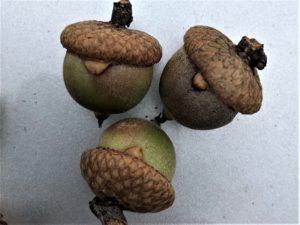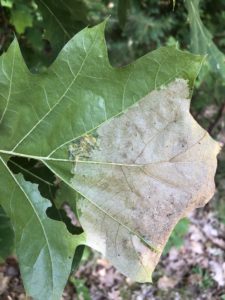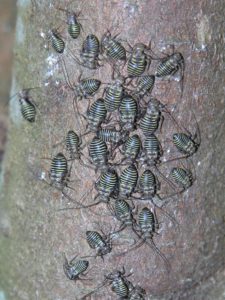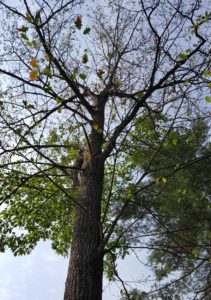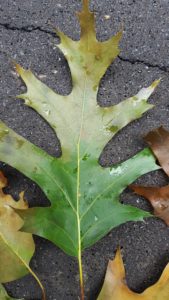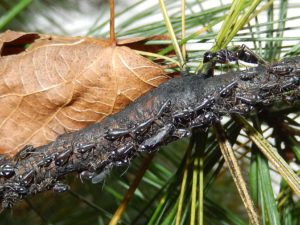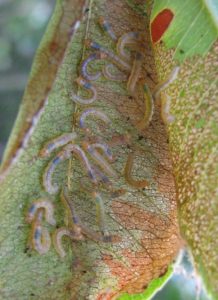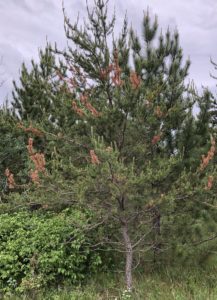On July 19 & 20, two separate lines of severe thunderstorms swept across Wisconsin causing significant forest damage in numerous counties. Straight line winds in excess of 100 mph and 16 documented tornadoes caused extensive damage to trees including main stem breakage, branches and tops broken, tipping and root damage and complete uprooting of trees. After the storms passed, the first order of business was to check on people, clear and open roads and make sure damaged homes were secured. As those tasks were completed, thoughts then turned to the damaged forests.
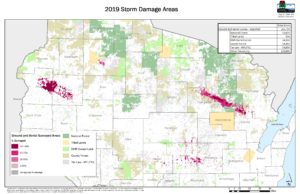
Coarse-scale damage assessment from recent storms in northern Wisconsin. Percent damage and number of acres affected were estimated during ground and aerial surveys.
Some insects and diseases can take advantage of storm-damaged trees and cause long-term damage to forest stands. Continue reading to learn more about these issues, how to deal with them and how to contact professionals who can help landowners make decisions about their land.
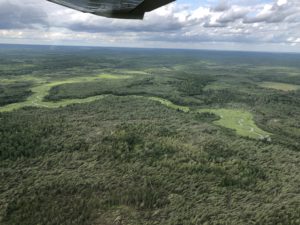
Aerial view of aspen trees leaning from high wind in storm event.
Pines are first priority
Storm-damaged pine stands should be a landowner’s top priority when deciding where to start. Salvaging pine is much more urgent than oak or other hardwood stands because damaged pines will quickly begin to stain, and insects and disease will rapidly infest the damaged trees.
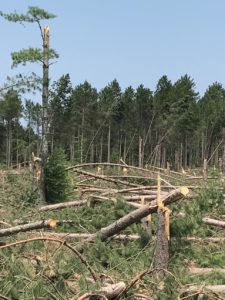
Bark beetles quickly attack leaning, broken or uprooted pines.
Native bark beetles such as red turpentine (Dendroctonus valens) and pine engraver (Ips pini) will rapidly attack damaged trees that are leaning, broken or uprooted as well as fresh logs in log decks. Bark beetles will continue to attack storm-damaged trees and can move on to attack healthy pine once their populations grow. For more info on bark beetles, check out the WI DNR bark beetle factsheet.
White-spotted sawyer (Monochamus scutellatus) is another native beetle that will move in when a pine tree is nearly dead (or freshly cut). If you’ve ever stood by a conifer log pile and heard scratchy chewing noises, you were listening to this native pine sawyer.
Armillaria is a fungus that attacks the roots of storm-damaged trees. Tree mortality from armillaria root disease won’t show up until 1-3 years after the storm.
The bottom line to minimize insect and disease issues is to harvest your pines as soon as possible after the storm. Check out this printer-friendly factsheet for more information about salvage harvests, pests and replanting in storm-damaged pine stands.
Heterobasidion root disease in pine and spruce
Heterobasidion root disease (HRD), previously known as annosum, is a serious fungal disease of conifers, particularly pine and spruce. Infected trees decline and eventually die. Infection occurs when a spore lands on a freshly cut stump and germinates. Once in a stand, the disease can move from an infected stump to nearby trees through root contact, eventually killing those neighboring trees.
If a pine or spruce stand is within 25 miles of a known HRD pocket and a harvest or salvage will be done, it is recommended to treat pine and spruce stumps with a preventative fungicide within 24 hours of the tree being cut. To find out if you’re within 25 miles of a known HRD pocket, check out the interactive HRD web map.
When salvaging storm-damaged trees, it may be difficult to quickly find a logger who is certified to apply pesticides or one who has the equipment to spray the stumps as they are being cut. It may also be impractical or impossible for logging equipment to cut and treat those trees that are down or broken. Although efforts should be made to arrange preventive stump treatment, under this type of emergency harvesting, treatment of stumps at the time of harvest may not be practical. Refer to the HRD guidelines and the modifications that reference salvage (Chapter 3, Modification 4, and Chapter 4, Modification 4). For more information about HRD, visit the DNR HRD webpage.
Hemlock borer
Hemlock borer (Melanophila fulvoguttata) is a flatheaded wood-boring beetle whose immature stage bores into stressed or recently killed hemlocks. Storm-damaged hemlocks provide a good breeding ground for hemlock borers, and their populations grow large enough that they attack living hemlocks. To avoid hemlock borer attack on living hemlocks, promptly salvage windblown hemlock following a storm event. If you must thin standing trees around living hemlocks, the intensity of thinning should be as light as possible.
Oaks and other hardwood stands

Counties shown in red have oak wilt throughout the county, although it may not be in every stand. Oak wilt is not common in northern Wisconsin.
Don’t rush – deterioration of oak is not an immediate concern. A thoughtful approach to salvaging your oak stands will be more beneficial in the long term. Oaks with broken roots or major branch/stem breakage may be attacked by the native two-lined chestnut borer (Agrilus bilineatus). Larvae of this beetle bore under the bark of oaks and can girdle and kill branches or entire trees. Branch mortality or whole tree mortality due to this insect will show up 1-3 years after a major stress event like these storms.
The good news is that the July 19 and 20 storms occurred after the high-risk period for new oak wilt infections. Oaks are highly susceptible to infection by the oak wilt fungus (Bretziella fagacearum) during spring and early summer (April 15 – July 15 in the north and April 1 – July 15 in southern Wisconsin). Oaks in the red oak group will be killed completely while just a branch may die on white and bur oaks.
If salvage of stands with oak will occur next spring during the high risk period, please see the oak wilt guidelines for information on harvesting to minimize introduction of oak wilt There is a guideline modification for salvage harvesting that you could consider, so check out the guidelines to decide what is best for your property. Read more about oak wilt on the DNR oak wilt webpage.
What to salvage
Uprooted trees, and those with completely broken tops, will die and should be salvaged. Standing trees with some broken branches are judgment calls. A general rule is to salvage the tree if more than 50% of the crown or top is broken, but there may be situations when these damaged trees could be left to help your forest recover. A professional forester can help you with these determinations. Trees that are leaning may have broken roots or broken stem fibers and should be considered for salvage. Check locally for wood disposal sites or refer to the DNR page on cleaning up storm debris.
Firewood
Storm-damaged trees can be utilized for firewood, but you should be careful not to move firewood long distances and risk introducing invasive species like emerald ash borer, gypsy moth and oak wilt to new areas. Instead, let the firewood age in place and burn it locally. For more information, visit the DNR firewood page. Always use proper protective equipment when operating a chainsaw.
Continued monitoring
Trees do not recover from stresses very quickly. Dieback, and even mortality associated with the storm, could continue for 2-3 years. Hail damage associated with the storms may not be apparent until next spring. You should continue to monitor your storm-damage stands for several years, especially if additional stresses occur in the year or years after the storm damage (such as a drought, defoliation, etc.). If you notice trees dying in the year following the storm or even two years after the storm, you should discuss this with your forester.
Replanting – when do you start over?
If you have a pine stand that was salvaged and you plan to replant to pine on that site, wait! Pales weevil (Hylobius pales) is a native insect that will infest freshly cut pine stumps. That alone is not a concern, but as new adults emerge from stumps, they must do a “maturation feeding” on conifer twigs, which can girdle them. If the only “twigs” available are the seedlings that you just planted then they will feed on those, possibly killing the seedling and causing extensive failure of your new planting. Wait for the second springtime following your salvage/harvest before you replant. Example: you salvaged your stand in August 2019, you should not replant until the spring of 2021. Another example: you salvage your stand in May 2020, you should not replant conifers on that site until spring of 2022.
Talk with a professional
If you’re still unsure of how to proceed with making decisions about the storm damage on your land, you should contact a professional forester or forest health specialist for insect and disease questions. You can also find lots of resources and information on recovery from the storm at the Wisconsin DNR storm damage page. Major storms like this can devastate a landscape and deal a crushing blow to the family forest. Discussing your options with a forester and creating a game plan that will benefit you and your land will start you on the road to forest recovery.
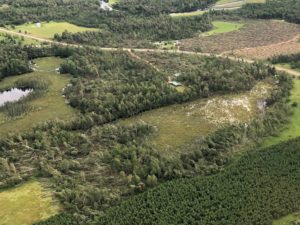
Storm damage was extensive in numerous counties. For scale, note the house near the center of this photo.
